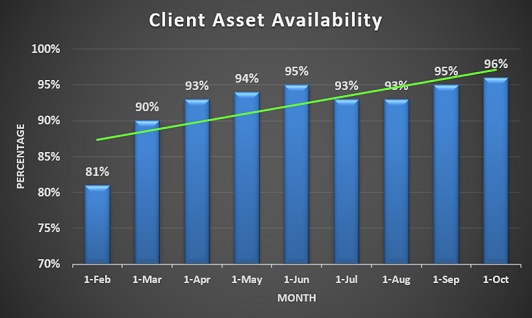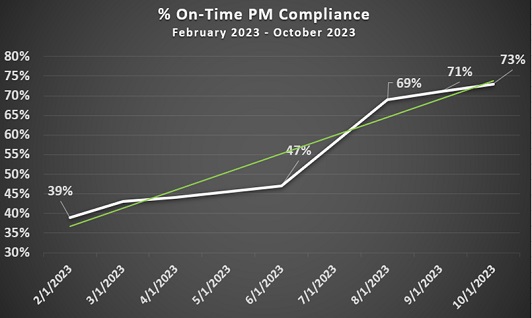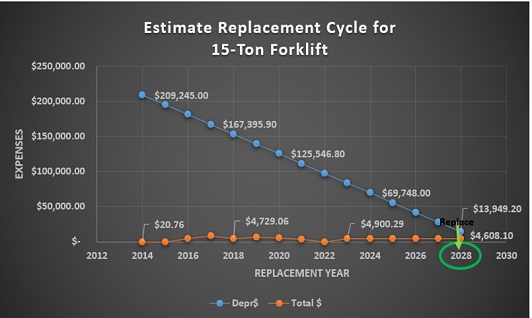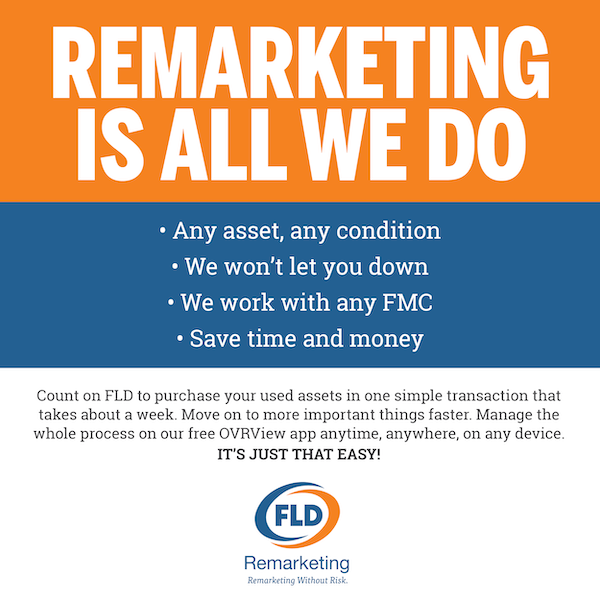
By Steve Saltzgiver, Fleet Success Sr. Advisor, RTA – The Fleet Success Company
November 8, 2023
Introduction
The goal was clear: “Transform the fleet’s overall performance, increase customer service, boost preventive maintenance compliance, reduce downtime, and increase asset availability.”
Over the course of this engagement, our RTA Interim Fleet Director quickly assessed the primary challenges by meeting with each of the department stakeholders served by the fleet maintenance operation to gain their insights and feedback. Next, the Interim Director met with the fleet team to solicit ideas for process improvement to meet department expectations. As a result of these stakeholder and fleet sessions, several issues were identified and prioritized:
- Department stakeholders were dissatisfied with fleet’s communication process.
- Out-of-service asset statuses were not conveyed routinely by fleet.
- Informal process in place to report down (i.e., broken) assets to stakeholders.
- Parts availability to repair assets was less than satisfactory.
- Preventive Maintenance (PM) compliance was not fleet’s primary focus.
- Asset replacement life cycles were “ad hoc”, rarely analyzed, and informal.
- Fleet team not formally trained on Fleet Management Information System (FMIS).
- Several gaps were present in accurate real-time data capture in the FMIS.
- Inefficient manual (i.e., paper-based) versus digital processes were the norm.
- Asset specification development was informal, lacking stakeholder feedback.
Using stakeholder feedback, the RTA Interim Director saw an immediate opportunity to increase stakeholder communication as priority number one by initiating a bi-weekly meeting cadence. Under normal circumstances, preventive maintenance (PM) would have been the number one focus to turn this fleet around quickly. However, because of the stakeholder and fleet team communication gap, the design and implementation of a daily ‘Asset Availability’ report was quickly implemented. This report gave each stakeholder a real-time snapshot of which assets were available to perform daily mission assignments.
 On-time PM compliance became the next critical priority as many unavailable assets resulted from “low or no” quality PM inspection services. Because PM compliance was not a major focus, the fleet shop had very few, if any, PM inspection checklists, allowing technicians to perform a good quality walk-around inspection. As such, the Interim Director and fleet team began to immediately create electronic PM checklists for each asset. Additionally, the fleet reviewed and updated every PM interval to align with each asset with the original equipment manufacturer (OEM) guidelines. The latter extended many PM intervals, thus resulting in the reduction of shop scheduling, shop space, time requirements, asset downtime, and expenses, as PMs were scheduled much more frequently than required by OEM recommendations.
On-time PM compliance became the next critical priority as many unavailable assets resulted from “low or no” quality PM inspection services. Because PM compliance was not a major focus, the fleet shop had very few, if any, PM inspection checklists, allowing technicians to perform a good quality walk-around inspection. As such, the Interim Director and fleet team began to immediately create electronic PM checklists for each asset. Additionally, the fleet reviewed and updated every PM interval to align with each asset with the original equipment manufacturer (OEM) guidelines. The latter extended many PM intervals, thus resulting in the reduction of shop scheduling, shop space, time requirements, asset downtime, and expenses, as PMs were scheduled much more frequently than required by OEM recommendations.
Following this careful assessment and planning process, RTA quickly turned the tables, elevating asset availability from 81% to an astonishing 96% and taking PM on-time compliance from a mere 39% to an impressive 73% in less than nine months.
Assessment and Planning
Upon assuming the role of Interim Fleet Director, the first step was to conduct a thorough assessment of the existing fleet operations. The Director quickly identified a series of key issues that were hampering fleet performance:
- Lack of Data-Driven Decision-Making: The client’s fleet was not leveraging the potential of data analytics to optimize maintenance schedules and asset allocation.
- Maintenance Backlog: There was a significant backlog of overdue maintenance tasks, leading to a higher risk of breakdowns and unexpected downtime.
- Inadequate Communication: Communication between the maintenance team, department heads, and drivers was sub-optimal, resulting in missed opportunities for preventive action.
- Resource Allocation: Resources were not allocated efficiently, leading to underutilized assets and, conversely, overworked vehicles.
- Insufficient Training: Maintenance personnel lacked up-to-date training on new technologies, the FMIS, and constantly evolving best fleet management practices.
Developing a Roadmap
With a clear understanding of the challenges at hand, the Director charted a short-term course for improvement. The roadmap included the following components:
- Data Analytics Implementation: We invested in fleet management software that could collect, process, and analyze data in real-time. This allowed us to track vehicle performance, anticipate maintenance needs, and make data-driven decisions.
- Streamlining Preventive Maintenance: We revamped the preventive maintenance schedule to ensure that tasks were allocated based on data insights, OEM guidelines, and actual usage patterns. This helped reduce the backlog and boost PM compliance.
- Enhanced Communication: The Director introduced regular meetings between departments, drivers, and maintenance teams to foster a culture of collaboration. Drivers were encouraged to report any issues promptly, and maintenance staff responded swiftly.
- Resource Optimization: Asset tracking technology was better used to monitor vehicle usage and allocate resources more effectively. This helped balance workloads and minimized wear and tear.
- Training and Skill Development: The Director invested in ongoing training and development programs for maintenance personnel to keep them updated on the FMIS, the latest industry standards, and technological advancements.
Challenges and Solutions
The journey to improve fleet performance was not without its challenges. Resistance to change, initial skepticism, and logistical hurdles were among the obstacles encountered. However, RTA addressed these challenges with determination and innovation:
- Resistance to Change: To overcome resistance, the Director engaged with employees at all levels, explaining the benefits of the changes and actively seeking their input.
- Skepticism: Regular communication, coupled with transparency in reporting improvements, helped in winning over any skeptics.
- Logistics: The Director implemented a phased approach to minimize disruptions, starting with the most critical changes first.
Results and Achievements
The fleet team and its stakeholder’s hard work and dedication paid off, as evidenced by the remarkable results achieved in just nine short months:
- Asset Availability: Asset availability, a critical factor in fleet operations, jumped from 81% to an outstanding 96%. This meant that vehicles were in service when needed for departments to perform critical mission tasks, minimizing downtime.
- Preventative Maintenance Compliance: Preventive maintenance on-time compliance soared from a dismal 39% in February 2023 to an impressive 73% by October 2023. This meant more vehicles were being serviced before issues and/or catastrophic component failures could escalate.
- Life Cycle Analysis: By regularly reviewing asset life cycles, the Director was able to prepare optimal replacement cycle analyses to gain valuable insights into each asset’s cost performance to begin making critical planning decisions on future asset replacement priorities. This afforded fleet to engage with each stakeholder to prepare replacement specifications in advance.
- Cost Reduction: By preventing breakdowns and optimizing maintenance, the client began to see a potential horizon emerging, leading to a significant reduction in unplanned maintenance events and unnecessary repair expenses toward overall fleet cost savings.
- Enhanced Reputation: Improved fleet performance positively impacted on the company’s reputation and customer satisfaction. Moving forward, fleet will begin to regularly pulse and solicit feedback from customers to further improve customer satisfaction.
- Litigation Avoidance: Increased fleet team training, fleet performance, and regulatory compliance resulting from on-time PM and mandatory government regulated inspections, elevated vehicle safety and lessened any potential for unnecessary legal exposure.
In Summary
Realistically, this nine-month journey was only the start of transforming a struggling fleet into a well-oiled machine. However, this journey has certainly been a testament to the power of strategic planning, data-driven decision-making, and teamwork. Although work exists to completely transform and improve additional processes and establish key metrics in this client fleet operation, this experience underscores the importance of performing a regular assessment, adaptability, and goal toward continuous improvement in the world of fleet management. By embracing change and innovation, RTA and the client not only boosted its bottom line using a seasoned fleet professional as Interim Fleet Director, but also set a new standard for fleet excellence within the fleet management community.








